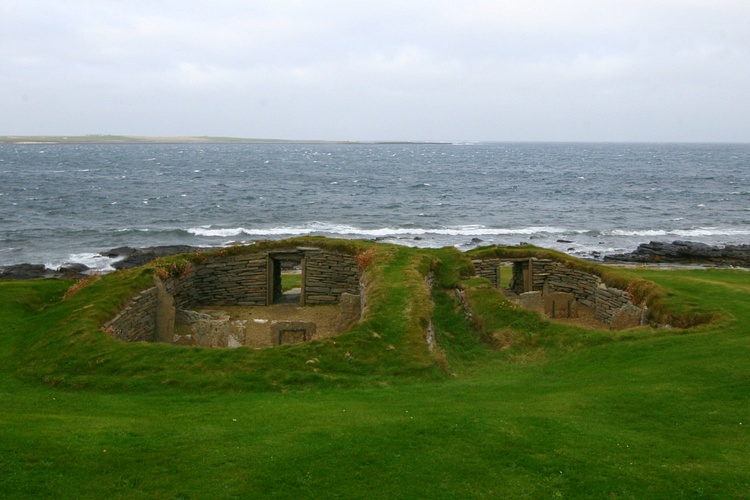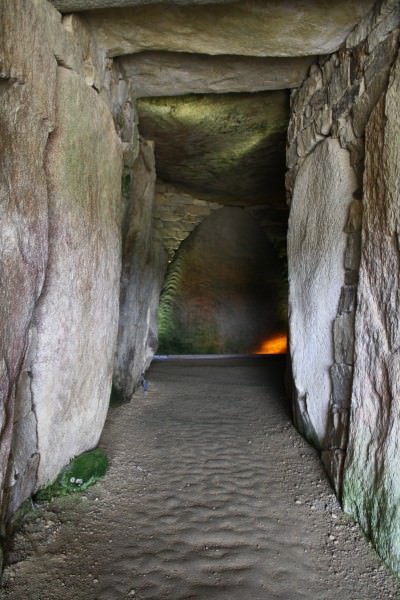Knap of Howar › Locmariaquer » Ancient origins
Articles and Definitions › Contents
- Knap of Howar › Ancient History
- Locmariaquer › Antique Origins
Ancient civilizations › Historical and archaeological sites
Knap of Howar › Ancient History
Definition and Origins

The Knap of Howar is a Neolithic site on the island of Papa Westray in Orkney, Scotland. The name is Old Norse for `mound of mounds' or `large barrow'. The building preserved at the site is considered the oldest stone house in northern Europe and is dated to 3700-3500 BCE. The site consists of two structures, commonly referred to as `the farmstead', built through dry stone construction with an adjoining passageway between them. Based upon archaeological excavations, it is thought that these structures were built on top of a much older site and formed the centre of a farming establishment.
The Old Norse name for the island of Papa Westray was Papay Meiri, meaning `Big Island of the Papars'. The Papars were legendary Irish or Scottish monks, referenced in Scandinavian works, who inhabited the northern islands of the Orkneys after leaving Iceland. As these sources for the Papars date from the 12th century CE, and the site is far older, it is possible these Papars were originally pagan priests who were later Christianized in legend. It is not possible, however, that Christian monks were the first builders and residents of the Knap of Howar (though there is much evidence on Papa Westray for later Christian activity) and it is almost certain that the inhabitants were a Neolithic Orcadian family of farmers. Archaeological evidence indicates the people there kept cattle and sheep and, perhaps, pigs, farmed the land to produce barley and wheat, and fished for food.
ONE OF THE BUILDINGS SERVED AS THE LIVING QUARTERS FOR THE FAMILY WHILE THE OTHER WAS A WORKSHOP AND STORAGE SPACE OF SOME KIND.
The stone walls of the farmstead stand to a height of five feet (1.6 metres) and, during the time of its occupation, would have been freestanding (today the building appears as though it was built into the earth). One of the buildings (House One) served as the living quarters for the family while the other (House Two), accessed through the adjoining passage, was a workshop and storage space of some kind. Both structures have doorways at the front facing the sea. The living quarters were relatively spacious at 35x18 feet (10x5 metres) and were separated by upright stone slabs which partitioned the front living area from a back kitchen or workroom. Evidence in the form of post holes suggests the roof would have been probably formed of turf raised some feet above the walls - though perhaps not too high in order to contain heat. The home was warmed by a fire in the hearth of the back (kitchen) area. The hearth is preserved intact as are the stone beds and shelves of the home. It is thought the beds would have been covered with heath to form mattresses.
House Two, the smaller of the buildings, measures 25x12 feet (7x3 metres) with thinner walls which stand to the same height as the main house. This building is partitioned into three areas; two seem to have been for storage and a third used as a workroom. Pottery shards and stone and flint tools were found on the floor throughout. There were two hearths and grinding stones also found in situ. The passage way connecting the two buildings was, at some point, blocked by stone, seemingly on purpose, and the workshop abandoned. The main house continued to be occupied long after the passageway was closed and archeologist Anna Ritchie concluded the site was in constant use for over 900 years. Today the Knap of Howar sits fairly close to the coast but, in its days of occupation, it would have been inland from the sea in what was probably a wide meadow.Archaeologists and geologists have both confirmed this theory based upon evidence at the site and geological studies of erosion patterns on the island.
The site was first excavated in the summer of 1929 CE when the owner of the land, William Traill, found the sturdy stone walls in the earth which had been partially uncovered by strong gales the preceding winter. With the aid of a friend, William Kirkness, he uncovered the two buildings and removed debris and artifacts. The two men dated the buildings to the Iron Age but excavations in the 1970's by Anna Ritchie placed the structures in the early Neolithic Age and, further, showed that the buildings were continually inhabited for over 900 years. Although much of the material of interest had been removed from the two buildings, Ritchie found evidence of Unstan ware pottery shards, indicating that the inhabitants had been in contact with and traded with people of central Orkney and possibly even further south. According to `Adventures in Archaeology ', “Since Unstan ware was found in the earliest type of tomb in the Orkneys, you would expect to find a similar one nearby for the people of Knap of Howar” yet nothing, so far, has been detected. It is possible that the tombs which existed long ago fell into the sea through the erosion of the land or that they simply remain concealed. Recent excavations at the site of the Ness of Brodgar, on the main island of Orkney, have shown conclusively that entire settlements, of great significance, can still lie buried in plain sight waiting to be revealed.
Locmariaquer › Antique Origins
Definition and Origins

Locmariaquer is a Stone Age site in north-west France distinguished by its two large stone tombs and massive granite standing stone or menhir. The monumental structures, all built within metres of each other, were built in the 5th millennium BCE by the local sedentary farming community and are amongst the most impressive Neolithic monuments anywhere.
GRAND-MENHIR
The huge igneous stone monolith known as the Grand-Menhir was a single piece of granite 20 metres tall and over 280 tonnes in weight. The engineering skills employed to move and erect such a massive stone are impressive, especially as the nearest source of such stone was 10 km distant. The menhir was carefully positioned, probably using earth ramps, at the end of an alignment of 18 interlocking stones c. 4,500 BCE, now destroyed but indicated at the site today. The menhir would have been finished off and given a smooth surface using quartz hammers. Another large menhir or stele once stood near the Grand-Menhir and two large pieces from it - identified by their ox carvings - were reused in the Table-des-Marchands tomb (tumulus) nearby (see below) and the stone tomb on the small island of Gavrinis across the Gulf of Morbihan 4 km away. The surface of the Grand-Menhir shows deliberate stud marks and a socket was made in the base of the stone to increase its stability when standing. Nevertheless, the giant subsequently toppled over and fractured into four large pieces. Whether this was due to natural causes such as high winds, lightning or an earthquake, or due to a deliberate breakage is unclear. More certain is the fall likely occurred only a few hundred years after its erection, sometime around 4,000 BCE.
DUE TO THE ACIDITY OF THE SOIL, NO HUMAN REMAINS HAVE BEEN FOUND IN THE TOMB, BUT EXCAVATIONS HAVE REVEALED FLINT TOOLS, JEWELLERY, AND A CERAMIC DISH.
ER-GRAH TUMULUS
The Er-Grah tumulus (or Er Vinglé in the local Breton language meaning 'quarry' and indicating the site's role as a source of building material in later times), located just a few metres from the Grand-Menhir, was probably constructed around 4,200 BCE. The single-person tomb measures 140 metres in length and ranges in width from 16 to 26 metres. Taking a trapezoid shape, the height is relatively modest at no more than 2 metres. The structure evolved over time, starting out in c. 4,500 BCE as a group of small burial mounds and ditches with some dwellings. Later, a rectangular cairn was constructed over the site, which incorporated a huge slab stone as a roof and which is still part of the structure today. In c. 4,000 BCE the cairn was extended using limestone covered with a surface layer matching the existing stones. Due to the acidity of the soil, no human remains have been found in the tomb, but excavations have revealed flint tools, jewellery, and a ceramic dish.

Neolithic Tumulus Interior, Locmariaquer
TABLE-DES-MARCHANDS TUMULUS
The large stone tomb known as the Table-des-Marchands was constructed c. 4,000 BCE. The monument's name (Table of the Merchants) derives from the huge stone slab incorporated into the roof of the interior chamber ( dolmen ) which measures 7 x 4 m and is 80 cm thick. The slab was, in fact, first fully-excavated in Roman times and is part of the stone whose other piece was used in the tumulus at Gavrinis. The stone mound at Locmariaquer measures 30 x 25 metres, but its present height is less than half of the original. The inner stone tomb and entrance corridor are made with large flat upright stones topped by horizontal slabs and dry masonry. The corridor allowed for additional burials to be added to the tomb over time. The inner tomb is an impressive 2.5 metres in height and includes a large pointed stone positioned facing the entrance, considered to represent a divinity. This large sandstone stele is covered with linear relief carvings and was originally set near the Grand-Menhir before being used within the tumulus. Other carvings on the interior stones include crooks, oxen, and axe heads.
LICENSE:
Article based on information obtained from these sources:with permission from the Website Ancient History Encyclopedia
Content is available under License Creative Commons: Attribution-NonCommercial-ShareAlike 3.0 Unported. CC-BY-NC-SA License